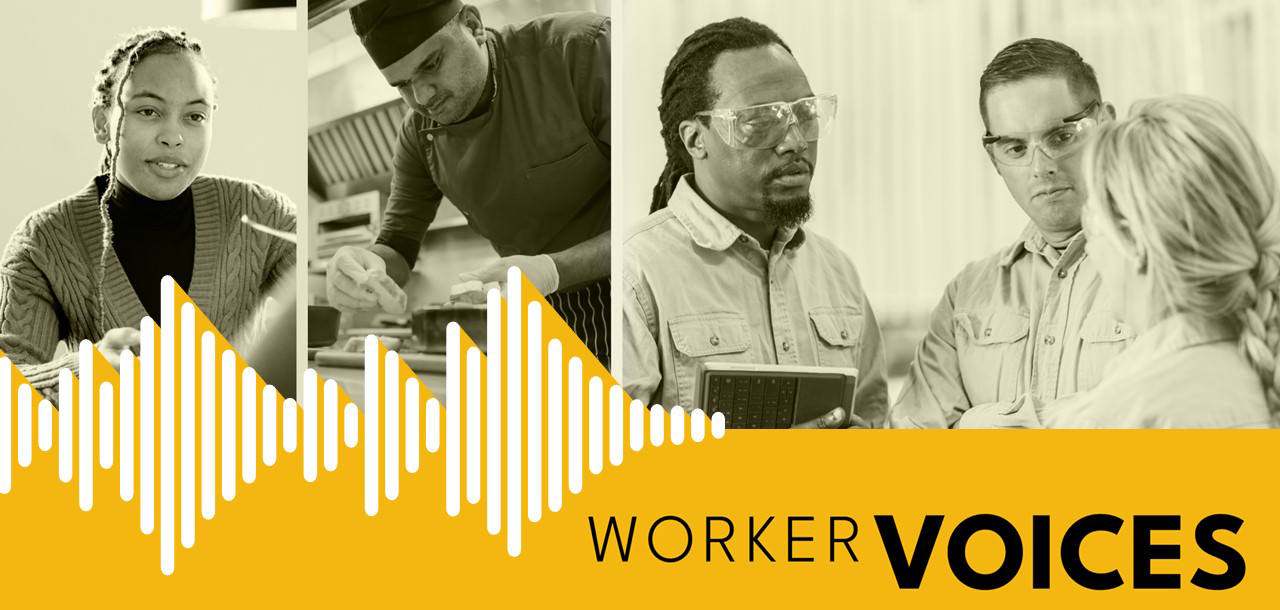
Executive Summary
Worker Voices: Shifting perspectives and expectations on employment
By Sarah Miller, Merissa Piazza, Ashley Putnam, Kristen Broady
May 24, 2023
Introduction
Gathering worker voices
During times of economic crisis, we look to the labor market to understand the strength of the nation’s economic recovery. As the COVID-19 pandemic entered its third year, the initial shocks of closures and layoffs had subsided, and indicators suggested the US economy was on the rebound. Unemployment was at historical lows, wages were rising, and employers were expanding hiring practices, attempting to open doors to more job seekers. Yet, in that same period, there were approximately two job openings for every one job seeker, indicating there were not enough workers in the job market. This disconnect raised a question: What are workers looking for in employment? With a robust debate among policymakers, researchers, and practitioners as to what was happening in a rapidly changing market, we turned our attention to understand how workers were navigating those changes.
The individuals who often feel the greatest impact of economic shocks are those who are already in financially unstable positions. In the job market, this includes low-wage workers, workers of color, and workers without a four-year degree. These workers bore the brunt of the initial pandemic layoffs, with increased job loss and rising instability of work. Previous downturns have demonstrated that these individuals are the first to lose their jobs and are slower to rebuild assets during subsequent recoveries.


These past two years, I’ve been laid off from work many times due to the COVID pandemic. I was interested in the title, ‘The worker’s voice,’ because it makes me think we have a voice, the voice of those who are not heard. And I felt the urge to share my experience with other people.
– Worker Voices participant
One of the tasks of the Federal Reserve is to take the pulse of economic conditions. Doing so helps achieve the Fed’s dual mandate of price stability and maximum employment. While employment data can provide a picture of unemployment, labor force participation, and unfilled jobs, they do not tell us the full story around disparities in recovery, nor do they tell us about worker experiences and preferences. This research paper sets out to capture those worker perspectives.
The Worker Voices Project is a Federal Reserve System research effort, started in May 2022, that engaged low-wage workers and nondegree job seekers through focus groups across the country to understand their experiences of the economy in the recovery. To capture the full picture of the nation’s economic health, this research looks beyond the numbers to understand the perceptions and motivations behind the decisions workers make. Listening to the voices of workers, especially those most vulnerable in the economy, helps us better understand the labor market and supports an inclusive and resilient economy.
In 2022, Federal Reserve researchers conducted focus groups across the US with workers and job seekers without a four-year degree to seek answers to the following questions.
- What were workers’ experiences with employment at the onset of the pandemic and during the economic recovery?
- Do these workers and job seekers believe that they are benefiting from strong labor market conditions and experiencing greater economic stability?
- What barriers persist and prevent them from returning to and then remaining in the labor market?
- How are they changing what they expect from a job, and how do changing expectations inform the choices they make around work going forward?
This qualitative research aims to add context to labor market research that leads to better understanding of worker preferences and behavior. The insights gleaned offer a nuanced perspective on how workers and job seekers, especially those without a four-year degree and in lower-wage roles, navigate employment and strive for economic stability in the labor market. Moreover, worker experiences and perspectives can provide insight into labor force participation complexities, aid in understanding successes or barriers related to long-term employment, inform the direction of future research, and underpin policy implications for workers marginally attached to the labor market.
Methodology
The study used focus groups as a qualitative methods technique to understand experiences, attitudes, and perceptions influencing worker behavior and attachment to the labor market, both during and after the pandemic. Participants were recruited through more than 60 community-based workforce development partners of the 12 Federal Reserve Banks. A total of 1,243 workers and job seekers responded to a screening questionnaire. Of those, researchers selected 175 participants between the ages of 20 and 55 years old and with less than a bachelor’s degree from 33 states to participate in 20 virtual, 90-minute focus groups, including one pilot session to refine questions and the facilitation process, conducted between May 2022 and September 2022. This study represents analysis of feedback from 167 participants through 19 focus groups conducted following the pilot session.
Participants engaged in this research, as they were identified through community-based workforce providers or training organizations, bias the study’s sample toward workers and job seekers who were more likely to have received employment placement services and supports or who were previously or are currently enrolled in training programs.
What we heard
Key findings from Worker Voices research
Complex calculations about health risks, family demands, and financial needs during the pandemic changed how many workers navigate the labor market.
Many workers in our study discussed experiencing the loss of loved ones, a loss of income, unstable employment, health issues, and increased strain on mental well-being. Meanwhile, challenges that they faced before the pandemic, such as those related to child care availability and public transportation options, only intensified during that period.
When navigating employment or employment loss and determining if and where to work during the pandemic, participants recounted facing complex choices as they evaluated and balanced a variety of concerns. For many, this process included weighing health and safety risks, caregiving needs, and barriers around transportation against the need for income and financial security. In addition, similar factors impacted their decisions whether to return to work following a job loss by choice or circumstance, or to continue working at all.
When making decisions around employment, participants discussed how pandemic-related benefits and relief through extended unemployment insurance and stimulus funds did cause a smoothing effect on dire financial situations. However, for some participants, these funds did not provide enough financial security to create an incentive for workers to stay on the sidelines of the labor market.
Worker decisions were often complex and nuanced, taking into account a variety of factors impacting their personal lives, their health and safety, and their income stability. Workers described their calculations around pandemic employment decisions as “traumatic” and “scary” experiences, which caused many participants to fundamentally change how they evaluate employment opportunities and affect how they navigate the labor market.


I’ll say for me, it wasn’t really easy. It was very challenging, because … I was very concerned for my health and for the health of my child. … I was also very scared because I thought maybe I could lose my job and I wasn’t going to be able to provide the necessary means for my children. And it was a very tough and challenging moment for me.
– Worker Voices participant


I’ve probably put in for the last three months about, I would say, 80 to 100 applications, and so since I haven’t been able to find a job. … I’ve been pulled in for interviews and not selected because I’m not what they’re looking for.
– Worker Voices participant
The tight labor market has not benefited all workers equally.
A tight labor market, one in which there are more jobs than job seekers, may have benefited some workers in the two years following the pandemic. However, many of the individuals who participated in our focus groups were still experiencing economic insecurity. Many described encountering job instability and struggling to find work or improve their employment opportunities, despite significant overall job availability. In addition, those in our focus groups who were currently working or had worked through the pandemic felt the strain of labor shortages, taking on more and more responsibility in their jobs without an increase in wages. This had sometimes led to mental, physical, and financial stress, as well as burnout.
Those actively searching for jobs, whether to return from unemployment or find a better employment situation, described sending out dozens, or even hundreds, of applications to no avail. Not hearing back from employers at all or being told they were not the right candidate for the role left participants feeling confused and frustrated as to why their efforts were unsuccessful, considering labor market conditions that were typically favorable to job seekers.
Workers expressed enhanced expectations of job quality.
Many participants shared how their experiences during the pandemic shifted both what they expect from and now look for in a job. In these discussions, many participants talked about the interrelated attributes of job quality, such as dignity and agency, job stability, safety, and flexibility, as well as compensation. Several participants noted that wages are not the only thing they consider when looking for a good job.
Many participants shared that they are looking for jobs that offer them dignity and agency and that make them feel valued and respected. They are seeking wages that are commensurate with their cost of living and that are proportional to the responsibilities they take on within the role.
Some participants also valued greater flexibility and a better work-life balance than they had previously experienced. Given their experiences with layoffs and precarious employment, especially at the height of the pandemic, many participants shared that stable and consistent employment was more important to them than it had been previously.


We want certain benefits, we want certain hours, certain schedules, and before the pandemic we were not like that. That is, what they gave us, we accepted because we needed the work. And after the pandemic we realized … work sometimes needs us more.
– Worker Voices participant


I’m trying to transition to software development. I’m going into software, going to working remotely. I feel like there’s more [job] security in that area. So, I’ve been taking some tutorials. It’s not been easy, but I’m still pushing through.
– Worker Voices participant
Many workers are reinventing themselves through skill development and self-investment to change their economic opportunities.
As they faced challenges presented by the pandemic and labor market, many participants in our focus groups continued to reinvent and invest in themselves to improve their economic opportunities. As their demand for quality jobs increased, workers shared how they were actively pursuing many forms of self-investment and improvement. These included formal learning through institutions of higher education or workforce training programs, bootcamps, and personal enrichment courses, as well as self-directed learning through online platforms such as YouTube. Others talked about their aspirations to engage in entrepreneurship or self-employment for nonfinancial benefits, such as being one’s own boss and having flexibility, because they felt the jobs available were not providing those benefits.
Some discussed prioritizing finding more stable employment with growth potential and described their upskilling and reskilling efforts as ways to be economically mobile in the short term and achieve economic stability in the long term. Many workers are pursuing new and traditional forms of skill development and self-investment, motivated to find better employment opportunities that meet their expectations of economic security and stability.
Considerations going forward
While the COVID-19 pandemic disrupted work and life for everyone, the workers and job seekers who participated in this study are part of a segment of the US population that faced particularly acute challenges. Their unique lived experiences provide important nuance to economic shocks and labor market dynamics, giving depth and an understanding of motivations for the trends we see at a macroeconomic level.
At the same time, these findings are relevant to understanding the ways in which workers in general navigate economic shocks, their definitions of job quality, and the methods by which workers are investing in their skills and reinventing themselves for the future. The workers who participated in this research provided critical perspectives to allow us to better understand the experiences of those in low-wage jobs in the labor market.
This study raises questions that make way for further research and inquiry around the current and future states of our labor market, as well as the future of worker expectations and preferences.


I think during the pandemic — it kind of flipped the tables a little bit. … I know that I can bring a lot to the table. Are you going to uphold your end of the half as an employer? So at least for me, it gave me a different perspective of … don’t settle for less.
– Worker Voices participant
- Cyclical or structural changes: Are these post–economic shocks structural or cyclical changes? If the shifts documented in this study are more than cyclical and represent structural changes in worker expectations and behavior, could this result constitute permanent changes to the labor market? Will employers engage differently with the workforce to ease hiring barriers and increase long-term retention in the labor market?
- Worker expectations and preferences: Will worker priorities around wages and job quality shift during an economic downturn, or will workers’ expectations and preferences persist and contribute to increased pressures to create better employment opportunities in the labor market? How will their participation in the post pandemic labor market change over time?
The perspectives documented in this research provide critical nuance around the needs of an important segment of the labor force. The information workers shared about their priorities and views on job quality can help employers consider ways to fill labor gaps and better hire, retain, and upskill talent. What the findings suggest about structural and persistent barriers to the labor market can inform workforce-focused agencies and nonprofit programs, influence employer behavior, and provide insights to shape future policies affecting workers.
The experiences of lower-wage workers and job seekers are worth capturing through further study and continued conversations to provide insight into labor force participation trends and the effect their engagement with employment will have on long-term economic growth.
To foster a more inclusive and resilient economy, it is imperative that low-income and nondegree workers have opportunities and connect to employment in any economic cycle and in the long-term. By including worker voices to inform policy and practice, we can work towards building an economy that works for all.




